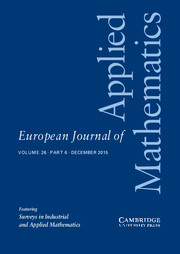Crossref Citations
This article has been cited by the following publications. This list is generated based on data provided by Crossref.
Myers, T. G.
1998.
Thin Films with High Surface Tension.
SIAM Review,
Vol. 40,
Issue. 3,
p.
441.
Momoniat, E.
2007.
A mapping of a generalisation of a thin film equation on a moving substrate.
Nonlinear Analysis: Theory, Methods & Applications,
Vol. 66,
Issue. 9,
p.
1980.
Higuera, F. J.
Medina, A.
and
Liñán, A.
2008.
Capillary rise of a liquid between two vertical plates making a small angle.
Physics of Fluids,
Vol. 20,
Issue. 10,
Quintans Carou, Judit
Wilson, Stephen K.
Mottram, Nigel J.
and
Duffy, Brian R.
2009.
Asymptotic and numerical analysis of a simple model for blade coating.
Journal of Engineering Mathematics,
Vol. 63,
Issue. 2-4,
p.
155.
Hewitt, I.J.
and
Balmforth, N.J.
2012.
Viscoplastic lubrication theory with application to bearings and the washboard instability of a planing plate.
Journal of Non-Newtonian Fluid Mechanics,
Vol. 169-170,
Issue. ,
p.
74.
Taroni, M.
Breward, C. J. W.
Howell, P. D.
Oliver, J. M.
and
Young, R. J. S.
2012.
The screen printing of a power-law fluid.
Journal of Engineering Mathematics,
Vol. 73,
Issue. 1,
p.
93.
Athukorallage, Bhagya
and
Iyer, Ram
2013.
Model of a contact lens and tear layer at static equilibrium.
p.
3605.
Trinh, Philippe H.
Wilson, Stephen K.
and
Stone, Howard A.
2014.
A pinned or free-floating rigid plate on a thin viscous film.
Journal of Fluid Mechanics,
Vol. 760,
Issue. ,
p.
407.
Butler, Matthew D
and
Vella, Dominic
2020.
Detachment in capillary adhesion: the relative roles of tilting and separation.
IMA Journal of Applied Mathematics,
Vol. 85,
Issue. 5,
p.
673.
Trinh, Philippe H.
Wilson, Stephen K.
and
Stone, Howard A.
2025.
A pinned elastic plate on a thin viscous film.
Journal of Fluid Mechanics,
Vol. 1007,
Issue. ,

